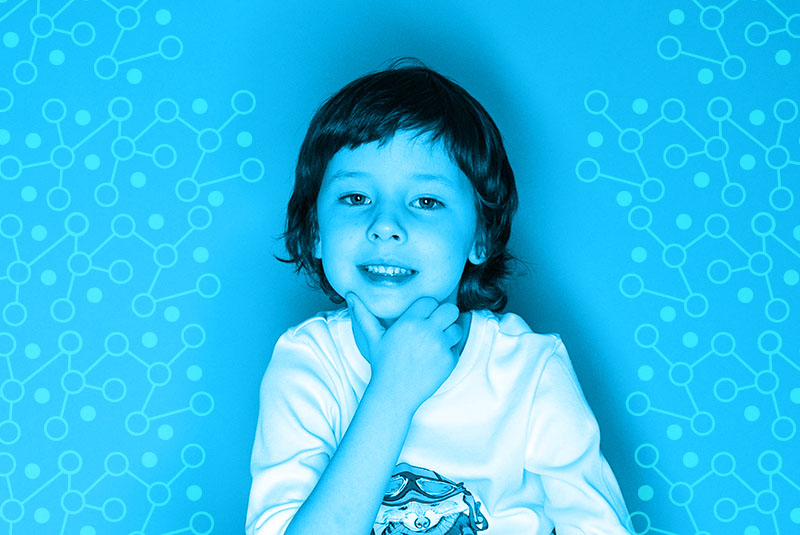Developing Critical Thinking
In Preteens
Introduction
Teaching your child how to think critically and how to be a critical thinker is now more than ever an important foundational responsibility of parenthood. Challenges abound and there are more pitfalls in today’s media and technology driven society.
Throughout this guide you’ll find case studies, practical exercises, resources, and informational pages designed to assist parents to better understand age specific developmental factors that influence how children can the necessary develop critical thinking skills they need to effectively navigate their formative years as well as their future adult lives.
The four factors (basic reasoning, self-esteem, emotional management, and social norms) we examined in the first part of this guide, concerning children aged five to nine, are still relevant when considering the development of critical thinking in young people aged 10 to 12.

Why is it important to develop critical thinking skills?
Critical thinking is the ability to think clearly and rationally about your actions and your surroundings. Children, given their formative stages of development, are especially vulnerable to outside influences as they’re still developing their capacity for independent thinking and personal identities.
A strong foundation with regard to critical thinking skills allows children to better navigate their surroundings and their relationships with their parents and peers, and even with themselves. The development of these skills is a lifelong process and you may find that even you, as a parent, can gain valuable insights into your own personal development.
Ways to increase critical thinking skills
The development of critical thinking in children aged 10 to 12 will be particularly influenced by the following three factors, around which this section of the guide is organized:
- The development of the ability to reason logically, allowing children to go beyond everyday argument.
- Puberty and its implications for children’s interests, self-esteem, and ability to manage their emotions.
- The digital universe, including video games, internet use, and the development of a new social life (or pseudo-social life) on social networks targeting young people.
These factors both deepen the child’s development in critical thinking and present new obstacles. There is much parents can do to help them further their development along productive tracks and avoid potential pitfalls.
In terms of reasoning, the big step forward at this age involves the heightened capacity for abstraction and formal logic. Where younger children apply rudimentary reasoning to concrete situations encountered in everyday life, the 10- to 12-year-old begins to draw more general conclusions from his or her everyday experience. Parents can encourage this move to greater abstraction by continually challenging their children with more complex discussions at home and by working on basic formal logic exercises with them.
This development is challenged by both the onset of puberty—along with the emotions and the process of individuation that accompany it—as well as by the new digital distractions children are increasingly exposed to during this period. Social networks, especially, can put a strain on children at this age.
But if adolescents manage to overcome some of these obstacles to cognitive development, critical thinking can itself serve as a way to channel some of their new energy, curiosity, and desire for independence. By recognizing the changes their child is going through and facilitating intellectual growth, parents can help make this challenging time an exciting and productive one, and prepare their children for the further cognitive advances to come in young adulthood.
1. Cognitive Biases
In children aged 10 to 12, the argumentative capabilities that we have analyzed in younger children can mature into lines of genuine reasoning, which are increasingly effective and cogent.
Logic, therefore, comes to play a more important role, even though at this age it is primarily applicable only in concrete and imaginable situations and remains subject to multiple cognitive biases.
What is cognitive bias?
Summary
As children’s cognitive capabilities mature, they begin to reason and make judgments about more complex topics. But children are often highly vulnerable to cognitive biases and errors at this age. They tend to generalize based on their own limited experience.
Parents can help by encouraging children to reflect on their limitations and by bringing up alternative perspectives.
What are examples of cognitive bias?
At a higher cognitive level (for example, in memorizing and recognizing), we encounter cognitive biases. For example, we memorize faces in the context in which we encounter them. If, for example, I only ever see the local baker in the bakery, we may well struggle to recognize each other if we meet by chance on vacation. This is a cognitive bias.
How can you overcome cognitive bias?
We have all experienced this human bias, but recognizing real life examples of cognitive bias requires a metacognitive process. Unfortunately, metacognition (that is, being aware of a bias) often does not help us correct it. As a rule, the lower the level at which the bias operates (for example, in perception), the greater its resistance to metacognition.
Yet, there is an area in which metacognition does manage to correct certain common cognitive biases: the sphere of social cognition. For example, our cognitive system tends to produce overgeneralizations, which is how social stereotypes are born. The idea that “women are kinder than men” is a social stereotype.
If we learn to understand through metacognition (that is, through a cognitive process capable of analyzing, even correcting, other cognitive processes) how our tendency to overgeneralize leads us to harmful, unjust, and even dangerous stereotypes, we can thus try to stop ourselves from overgeneralizing and overcome common biases. In social cognition, metacognition (which can be improved with practice) is effective in reducing the possibly disastrous effects of cognitive biases.
2. The Development of Reason
What does reasoning mean?
Reasoning is defined as the process by which you reach a conclusion after thinking about all the facts. There are several types of reasoning and each provide some insight into how the human mind processes information. The most commonly referenced types of reasoning are deductive reasoning, inductive reasoning, and abductive reasoning.
What are 3 types of reasoning?
Deductive reasoning is a formal logic process of reasoning that uses information from one or more statements or premises to reach a logically certain conclusion. It’s a form of top-down formal logic that you use everyday to navigate both small and large tasks and problems.
Inductive reasoning is a method of reasoning in which observations are taken and considered as evidence for a plausible truth. It’s a bottom-up logic that unlike deductive reasoning doesn’t end with a certain conclusion but rather a probable conclusion.
Abductive reasoning is a form of logical inference that seeks to find the most likely conclusion from a set of observations. Like inductive reasoning this form of reasoning leads to a probable conclusion rather than a certain conclusion. Where they differ is that abductive reasoning looks for a cause and effect relationship whereas inductive reasoning seeks to form probable conclusions from general rules.
Summary
At this age, children’s reasoning evolves from a focus on the concrete world toward increasingly abstract problems. Children make progress by way of challenges that force them to think more abstractly.
Parents can help by supplementing their school learning with games, discussions, and problems that exercise their emerging logic and reasoning abilities.
Reasoning skills
In terms of reasoning skills, children aged 10 to 12 undergo a stage between the “concrete operational stage” (where children reason only with immediately present objects) and the “formal operational stage” (where abstract reasoning detached from the sensory world becomes possible).
It is worth reiterating that from the age of nine or 10, children improve their ability to conceptualize and create lines of reason and reasoning that still nonetheless require a direct relationship to concrete factors. A certain degree of abstraction also allows children to develop reasoning ability and grapple with disciplines like mathematics beyond arithmetic. It becomes possible for them to resolve problems involving numbers and reasoning, but which still involve immediately present objects. The ability to systematically resolve abstract problems involving several variables is rare at this stage.
From the age of 11 to 12, children gradually develop what Piaget called “formal operations.” The new capacities that come with this stage, such as working logically with if-then statements and establishing abstract relationships, are generally mastered around the age of 15 or 16. At the end of this stage, teenagers can, like adults, use formal and abstract logic, but only if they have learned the language of logic (“if,” “then,” “therefore,” etc.) and have practiced using it. Teenagers also become capable of extrapolating and generalizing on the basis of concrete situations.
Therefore, between the ages of 10 and 12, children should be stimulated intellectually and pushed to reflect on and establish lines of basic logical reasoning. In this way parents can help them gradually move beyond the everyday logic based on action and observation onto logic based on rules of deduction that are independent of the situation at hand.
Reasoning examples
Our mind develops concepts by extracting shared features from a variety of different objects. For example, young children who hear the word “tree” spoken by others every time they encounter a dry plant 1 to 2 meters tall (dry climate trees like the Sahelian tree) will automatically extract shared features in order to produce a model of the concept of a tree.
But they have never had a formal definition of the word. If we take these children to a temperate climate for the first time, stand under a verdant 20-meter oak tree, and tell them it is a tree too, their previously established model will collapse. This immense object, very leafy and very green, with a central, vertical trunk, does not respond to their “visual concept” of a tree—based only on small, dry plants. This collapse forces the cognitive system to revise its concept of tree, defining it with more complex and increasingly abstract properties that are common to the large, green oak tree and the small, dry plant.

Patterns and Reasoning
We learn about our environment and our native language in this way, departing from concrete situations and creating an assembly of memorized links between words and sensory representations.
It would be convenient to have a formal, universal definition for a tree and to simply insert it into a child’s cognitive system. But this is impossible: on the one hand, because children have yet to master basic language and even less so logical language; and on the other, because children are not yet capable of learning by deduction.
But children can train themselves to identify and extract invariable properties of increasing complexity—creating a mental representation of the world by repeatedly calling into question and refining the concepts created by the cognitive system. Through this process and through the progressive accumulation of vocabulary, children become capable of extracting representations not only from sensory fact, but also from previously memorized representations.
One way to define thinking is the articulation of representations combined at will through language in one’s mind. When this combination of representations is structured by links of deduction (if-then statements), this thought becomes reasoning.
A field of immense possibilities opens up before teenagers, who become able to reason toward universal conclusions in unfamiliar contexts.

Near age 10, situations requiring logical deduction will be gradually encountered at school. Students will be forced to consider when and how to use basic operations to resolve concrete problems. These situations are also sometimes encountered in a family setting, if the child’s parents promote an environment favorable to reasoning and if they take the time to make sure it benefits their child.
Through encountering situations requiring deduction, in which we collect data, work through it rationally, and reach a conclusion, children will gradually manage to identify invariable properties in the data and to internalize the rules for deduction.
This begins developing slowly but surely around the age of 11 and stabilizes toward the ages of 14 to 15. This is how children reach the formal operational stage. Reasoning no longer requires imaginable, concrete situations. It no longer requires concrete elements, and it is even freed of the need to draw on memories of previously resolved problems. A field of immense possibilities opens up before teenagers, who become able to reason toward universal conclusions in unfamiliar contexts.
But this only happens if they are spurred on by having problems to resolve. Logical ability only improves with training. Adults must therefore encourage children to resolve problems. The struggle will create multiple new neural pathways and networks in the brain. These challenges are indispensable for the development of the brain and the capacity for reasoning.
3. Universal Reasoning
The capacity for universal reasoning—using the logical rules of deduction—begins to grow around the ages of 10 to 12. This means children can start using logic in situations that are not concrete—in areas that seem ruled only by language. The development of this faculty allows children to turn a critical gaze on someone else’s remarks. At this age, reasoning can become a powerful tool, especially to combat faulty or misleading reasoning.
During this intermediary stage, between the ages of 10 and 12, it is fundamental that parents train themselves if they are to aid the development of logical competence and critical reasoning in their children. To this end, families can play logic games, escape games, enigmas, or investigative games such as Clue together, combining the task of reasoning with fun.
Summary
As their reasoning becomes more abstract, children can begin to construct arguments of increasing complexity. They also start learning to identify errors in other people’s arguments.
If the child rounds off what they have learned at school within a family environment which promotes reasoning, this places their critical faculties in good stead when it comes time to progress onto more powerful, more universal critical reasoning.
We have seen that from the ages of five to 10, argumentation is a way of nourishing the child’s critical faculties in the period prior to the development of reasoning faculties. From the age of 10, the development of logical skills and the growing body of acquired knowledge will allow the child to combine argumentation and reasoning to support the effective use of critical thinking.
It is far easier to weaken, or even disprove, an idea through critical reasoning than it is to demonstrate its validity. For example, if someone makes a sweeping statement like, “Female politicians are all less aggressive than male politicians,” one needs only to use a counterexample to prove that this is false.
It would be more difficult to disprove the claim that female politicians are less aggressive than male politicians, on average. We cannot prove this false by way of a counterexample, a single “aggressive” female politician.
This kind of logical error is often made even by adults. Demonstrating that the latter proposition is true or false would require a rigorous method, reliable indicators, and statistical calculations. By undertaking this kind of logical procedure, we can teach older children to go beyond mere argumentation.

4. Puberty and Adolescence
Encouraging effort in the name of deferred gratification
When the reproductive system begins to function, sexual hormones induce changes and veritable upheavals on every level. The brain is deeply impacted, and several interests and character traits can change considerably.
Puberty is itself influenced by numerous biological, psychological, cognitive, sociological, and chemical factors. We are seeing an increasingly early onset of puberty as a result of synthetic chemical substances called endocrine disruptors.
Summary
The age between 10 and 12 is particularly fraught for many children because of the physical changes brought on by puberty. It is also a transitional phase in their cognitive development. Strong critical thinking skills can help stabilize this period, especially if children are able, with the help of their parents, to avoid distractions.
Exposure to media outlets and the internet plays a role in this as well: sexualized content that is increasingly accessible to young people contributes to directing their central nervous and hormonal systems (consciously or not) toward competition, seduction, aggression, and sexual impulses—in short, toward the survival of the species.
The immediate pursuit of pleasure is encouraged prematurely in pre-adolescents by advertising, magazines, films, TV, and the internet. Social norms also push in this direction: sports personalities, artists, educators, and psychologists talk more about pleasure than they do about effort. Yet, we have seen that, at the age when puberty starts, reasoning and formal logic gradually start to take root through practice and intellectual effort.
There are two opposing movements at play. On the one hand, we have the development of knowledge and understanding (language, reasoning, problem solving). This takes place through school, family, sports, the arts, and certain media outlets that can aid the development of the faculties of reasoning and critical argumentation.
On the other hand, puberty and the norms of immediate gratification and freedom for all tend to direct thoughts and behavior toward rapidly attained pleasures that require the least possible effort—far from the demands of critical thinking.

It is therefore wise to start training children as early as possible (from earliest childhood) to use their faculties of reasoning. Once this habit has taken root, not even puberty or phases of adolescent conflict can destroy these critical faculties. They become something akin to a second language.
Teenagers do not destroy their mother tongue even if they reject virtually everything associated with their family and society. They may use terms and expressions specific to their age group, but these remain rooted to the language they learned when they were younger.
The window between the ages of 10 and 12—the pivotal moment between childhood and adolescence—is an optimal time for developing and consolidating critical faculties.

Likewise attitudes, behavior, and understanding acquired prior to their adolescence may be called into question during this critical period. But they are not wholly eliminated, and they also return at the end of adolescence. This is, in fact, how our culture is passed down.
The window between the ages of 10 and 12—the pivotal moment between childhood and adolescence—is an optimal time for developing and consolidating critical faculties.
In fact, intellectual curiosity is often high as students reach the end of primary school. Psychoanalyst Melanie Klein called this thirst for learning, “the epistemophilic instinct.” Freud spoke of the sublimation of impulses at this stage, that is, the diverting of energy from unconscious sexual impulses toward sporting or intellectual activities.
We should seize this moment before puberty to direct children toward intellectual pleasure and critical reasoning. Children from ages 10 to 12 have the capacity to hone their critical faculties for reasoning and argumentation. They must be exposed to a multitude of subjects and be encouraged not to accept everything they read or hear. In a majority of cases, this works well. The influence of parents and schools remains solid even as the need to affirm and distinguish oneself develops.
5. Adolescent Social Life
Social development in adolescence
In addition to changes in personality and behavior, puberty tends to set in motion changes to the child’s social life. It generates a massive boost of individuation in children, and thus their parents’ “fall from grace.” Children begin distancing themselves from their parents, both on a psychological level and at the level of occupations and interests.
Pre-adolescents start to define themselves by their circle of friends at school or elsewhere. New social influences gradually contribute to the decoupling of children from their parents.
In these new social encounters, as well as in intellectual challenges, children often experience error and failure along with many other social challenges of adolescence. These can be tough experiences at this age in terms of identity and emotion. On a neurophysiological level, sexual hormones increase emotional instability. On a psychological level, the conflict between the desire for emancipation, on the one hand, and inexperience and gaps in knowledge, on the other, brings failure, notably in human relationships.
Children seek to break out of the family cocoon through their ideas, tastes, actions, and activities. But their lack of experience often makes them awkward. Parents must help them to deal with their errors in practical terms and without histrionics. Parents must also encourage them to persevere without bringing their whole existence into question at the slightest mistake.
Summary
Children’s social lives tend to undergo dramatic changes around this age, presenting new challenges. These can put a strain on children’s emotions. Parents can help by encouraging growth and new intellectual pursuits pursuits as well as helping children identify interests that will engage them.
Emotional social development in adolescence
At 10 to 12 years of age, emotional management becomes challenging. Emotional management takes place in nerve centers that are still immature at this stage. And puberty, of course, intensifies emotions and can lead children to act out.
By spending enjoyable downtime with their children (going fishing or playing chess, for example) parents can help them rein in the chaotic side of their emotions and restore a sense of calm while addressing the social needs of adolescence. With their emotions in check, children can access their critical faculties more serenely, drawing upon their cognitive faculties without being overwhelmed by emotions that are too strong to manage.
At this age, critical faculties can respond to rigorous intellectual demands. The prefrontal lobe has developed considerably, allowing executive functions to analyze situations, break down problems, and plan the stages and actions required to resolve them. This executive understanding combines with a growing mastery of language—both in comprehension and production—to develop critical reasoning and enable children to deal with complex situations or ideas.
But we must consider the growing individuality of pre-adolescents and help them find and develop their own interests so that they can invest in them and hone their critical faculties on them. Cultivating their interests and assisting them in their reasoning not only helps critical faculties mature into ingrained character traits, but also helps critical thinking mature into critical reasoning. By finding happiness in applying their reasoned point of view to areas that interest them, children will learn to practice such critical reasoning more generally.
At this age, other people’s perspectives play an increasingly important role for children. Though they may seem to be becoming more independent, often children are just coming under new influences. Friends, YouTubers, and other figures gradually replace parents.
What are some factors that influence emotional changes throughout adolescence?
We must consider the growing individuality of pre-adolescents and help them find and develop their own interests so that they can invest in them and hone their critical faculties on them. Cultivating their interests and assisting them in their reasoning not only helps critical faculties mature into ingrained character traits, but also helps critical thinking mature into critical reasoning. By finding happiness in applying their reasoned point of view to areas that interest them, children will learn to practice such critical reasoning more generally.
At this age, other people’s perspectives play an increasingly important role for children. Though they may seem to be becoming more independent, often children are just coming under new influences. Friends, YouTubers, and other figures gradually replace parents as their social development deepens..
Parents should alternate between playing the role of educators and protectors and that of supportive “friends” who help their children become individuals.

It is essential to reinforce positive sentiments toward children and to spend quality time that is not “educational” with them. This maintains a healthy bond and parents’ influence despite normal and necessary individuation. Quality time such as this will contribute greatly to maintaining high levels of self-esteem. Children also won’t feel as if they are simply education receptacles. By participating in, rather than resisting, individuation parents can better protect their children from harmful influences of undesirable friends or the internet.
Self-Esteem
For children aged 10 to 12, social aspects of adolescence and the development of self-esteem are intrinsically tied. This requires striking a balance between educational time and time for fun, where the hierarchy of teaching is put on hold. In such moments, children feel that they’re being treated as people and can more easily accept the advice and authority of parents and educators in the face of other influences, which may turn out to be harmful or dangerous.
Parents should alternate between playing the role of educators and protectors and that of supportive “friends” who help their children become individuals. If this balance is struck successfully, children’s self-esteem becomes firmly rooted. Their critical faculties can, furthermore, be used to reject harmful influences.
But from this point onward, an opposing force to critical thinking is a part of many children’s lives: the digital universe.
6. Media and Children
For 10 to 12 year olds, the digital universe is principally centered on two domains: gaming and using the internet to watch videos or simply browse.
We have seen how puberty exacerbates emotions, which makes it more difficult to manage them. The primary challenge is to resist the temptations of instant gratification and of giving in to one’s impulses. Controlling and distancing oneself from one’s own emotions is indispensable to critical thinking and reasoning at any age.
Impact of media on children
You may be wondering what are the negative effects of media. The digital universe has an adverse effect primarily on emotional control.
Summary
At this challenging age, digital distractions can easily become a way for children to avoid painful emotions. Parental control software and other limits can help control how media influences child development. But it’s more important that parents help their children work through these emotions. Parents should also spend time discussing the harms of excessive screen time with their children.
Firstly, gaming, like web browsing, transports us into the realm of imagination and magic, akin to that of our earliest childhood. For example, we can have many lives after having been “killed,” we can teleport wherever we like, and we can rapidly obtain answers to numerous questions. This begs the question of what effect this has on the immediate gratification of our impulses. Yet, this seemingly infinite power does not reward the effort and distancing necessary for the development of critical thinking and reasoning.
Moreover, we have seen that children’s distancing themselves from their parents is complicated, notably because their identities are still works in progress. Online, children witness the emergence of a new cohort of idols from YouTube and elsewhere. They also encounter multiple characters while gaming; they can even begin to identify with these characters.
In this way, grappling with frustrations linked to puberty (foiled freedoms and impulses) and with an identity still “under construction,” children can escape their negative emotions through gaming: at the push of a button they can enter a separate world. Alternatively, they can assume an online life through videos posted by other children.

By fleeing their emotions through digital distractions, children deprive themselves of an opportunity to reflect on and overcome their emotions and impulses.

How media influences children's behaviour
7. Video Game Addiction
Causes of video game addiction
Video games are more accessible and inexpensive than ever. Phones, tablets, and computers can all be used for playing video games. And the days when video games could only be played on pricey consoles are long gone. Accordingly, the video-game business model is evolving.
Today, many children aged 10 to 12 own a phone, a tablet, and/or a console. And, of course, today these technologies can all be easily and systematically connected via the internet. The “freemium” subscription model entices many children to nag their parents to purchase such-and-such virtual accessory. A game that was initially free can end up costing a lot of money.
Summary
Video games are more widespread and accessible than ever. Addiction and overexposure are genuine problems that can stunt children’s cognitive development. Parents should be clear about these problems with their children and take steps to address them early on.
We know that this intermediary period between childhood and adolescence is a sensitive time. Many children, especially boys, are drawn in by games in which power and violence predominate. These video games respond simultaneously to impulses aroused by puberty and to the need to escape the unpleasant realities of daily life (e.g., school). Such games are more and more commonly designed to be addictive. Today, children’s addiction to video games is an affliction recognized by both psychiatrists and psychologists. Of course, not every child who plays these games reaches this point, but addiction must be recognized as a danger.
When asking how to stop video game addiction it’s important to understand the underlying mechanisms at play. Our brains are genetically programmed to seek pleasure and satisfy our impulses. It is only education that can lead children to control and defer their impulses. The pleasure of playing a video game and being forced to stop sets off a sensation of withdrawal from the so-called neurological reward circuit. This is the same addictive mechanism at work with drugs, cigarettes, and alcohol.
The part of the brain which allows us to defer pleasure and control our emotions and impulses is located in the prefrontal lobe. If children regularly cave in the face of immediate gratification, they do not have the mental energy to self-regulate. From the age of 10 to 12, the prefrontal lobe, whose function is to inhibit, is far from being fully developed (which happens after the age of 20). What’s more, the less children try to stop themselves playing, the less they reinforce their inhibitive neural networks, and the more difficult this task becomes.

Anyone who becomes a video game addict, be they a child or adult, begins losing interest in other activities.

Effects of video game addiction
What relationship can we establish between this phenomenon and the development of critical thinking and reasoning? Addiction to any substance or activity adversely affects our self-image. Anyone who finds themselves addicted, be they children or adults, begins losing interest in other activities. They don’t feel that intellectual, cultural, or sporting activities have anything to offer. The only things that are important are immediate gratification and that which invokes it. This no longer leaves any room for critical thinking and reasoning and can even cause regression.
Addicted children will rationalize their lack of motivation by stating that everything else is uninteresting and that they play the game out of free will—because it’s the only interesting thing out there. This absence of critical thinking about oneself will forestall the possibility of shaking the addiction and even leads to video game withdrawal.
Overexposure to video games can therefore be disastrous for pre-adolescents and teenagers in terms of the development of their critical faculties. It can affect children’s future for good. It can deprive children from experience in sublimating their impulses and in taking joy in learning.
How to stop video game addiction
- Wait as long as possible before introducing children to video games, other than those which are cognitively or intellectually stimulating.
- Guide children in the direction of games that do not play into impulses linked to domination, violence, or seduction, but that instead stimulate curiosity and reflection. You can find some good examples here.
- If children have already taken a liking to an addictive game, it will be necessary to limit their access to it and to make it conditional on participating in other activities that facilitate critical thinking and reasoning.
- Parents should also converse with an addicted child to try to get them to recognize that games are stifling his or her interest in other things.
8. Children and the Internet
The Internet can be an extraordinary tool for developing children’s critical faculties, but, if it’s used without care or reflection, it can quickly become toxic.
Everything that has been said about video games also applies to various parts of the internet.
Studies have shown that a significant percentage of children have already watched pornographic videos. Just as in the case of video games, these videos can become addictive and have the same effects on critical thinking and reasoning. Moreover, unlimited viewing of pornography from the age of 10 to 12 disturbs children when they are at an important developmental stage.
Also troubling can be the personal channels run by video content creators. Certain channels have millions of followers who are often very young children. Some of this content is, well, drivel, and some inspires violent, provocative, and/or disrespectful behavior.
The Internet is, for this younger generation, the place where the “truth”—the world beyond their limited experience—emerges. Earlier generations had the same relationship to what they saw on television. But the internet has an almost boundless capacity for broadcasting, targeting, and updating.
Summary
Like video games, the internet can pose serious problems for children’s cognitive development. Online advertising, inappropriate content, and bad information can all hamper children’s critical faculties.
Parents should impose limits, keep an eye on their children’s activity and habits, and spend time browsing the internet with their children and practicing good habits.
We must help children learn to evaluate information online by reading and browsing attentively and checking facts.

Internet safety for children
“Fake news” arises from the convergence of this power, the ill intentions of certain agents, and a lack of critical acumen in consumers analyzing information. This is a growing problem. We must help children learn to evaluate information online through attentive reading and fact-checking.
Texts, videos, and photos are always uploaded for a particular reason. We must first teach children, as soon as they start using the internet, that online content on is not necessarily true. This must be repeated tirelessly.
Sources must be viewed as having varying degrees of credibility (something that bears repeating to adults as well). Wikipedia should not be equated with reputable educational institutions like Harvard or Oxford. We should also teach students which sites are reliable for each area of knowledge, whether it be IT, science, or culture.

How should parents monitor their children's internet use
Parental supervision on the internet is essential. Parents should keep quantitative and qualitative surveillance over children’s Internet browsing. For this, parental control software is required. But this is becoming more and more difficult, notably because of mobile phones, which can access the internet in its entirety. It is therefore necessary to spend time browsing with children, to set a good example of healthy browsing habits. Stupid, derisive, pornographic, and violent websites and videos must be forbidden.
Internet risks for children are numerous. That said, we must not lose sight of the fact that the internet also provides a magnificent opportunity to develop children’s critical faculties. If children are guided well by their teachers and parents, they will find many activities to nourish their curiosity, increase their general knowledge, laugh, and encounter artistic (or other) expressions of emotions. They can also be entertained by videos on the art of rhetoric and logic, which are not taught in elementary or primary school.
Excellent content and methodology for developing critical and reasoning faculties can be found on the internet. It is all a question of adults guiding children. The adults themselves must call into question their own use of the internet and their own application of their critical faculties. We can only teach what we know. Here are a few examples of reliable educational content online:
PBS | Encyclopedia Britannica | Library of Congress | Digital Public Library of America | Khan Academy | TedEd
Reboot Case Studies
Lorem ipsum dolor sit amet, consectetur adipiscing elit, sed do eiusmod tempor incididunt ut labore et dolore magna aliqua. Ut enim ad minim veniam, quis nostrud exercitation ullamco laboris nisi ut aliquip ex ea commodo consequat. Duis aute irure dolor in reprehenderit in voluptate velit esse cillum dolore eu fugiat nulla pariatur. Excepteur sint occaecat cupidatat non proident, sunt in culpa qui officia deserunt mollit anim id est laborum.
Case Study

Universal Reasoning
Whereas younger children are typically only capable of refining their everyday reasoning, which is bound to a particular concrete situation, adolescents are increasingly able to use abstract reasoning and formal logic in arguments. They can formulate and evaluate deductive arguments.
At this stage, therefore, parents should begin to push their children to formulate arguments in more coherent logical terms. They should point out mistakes in logical deduction, logical leaps, or the use of unwarranted generalizations, and they should challenge their children to use more abstract reasoning in evaluating the claims that others make.
Consider the following anecdote:
Lionel, 11 years old, says to Pamela: “Motorcyclists are all reckless drivers. My father doesn’t have a motorcycle. So he’s not a reckless driver.”
From the age of 10, more and more children, when tasked with a puzzle requiring the use of logic, can respond like Helen does: “Just because your father doesn’t have a motorcycle doesn’t mean he’s not a reckless driver.”
It is unlikely that a 10 year old would come up with such a response but it becomes increasingly likely as they approach the age of 15.
Yet, some adults can make claims like Lionel’s over the entire course of their lives, fostering a culture of illogical thought within their respective families. This will contribute to difficulties with mathematics, which will appear as soon as higher reasoning beyond arithmetic is required.
At this age, it is possible for children to begin to grasp logical concepts and logical entailment more precisely. Their development in this regard can be helped by prompting from parents and teachers. Ask them, for example, to explain exactly why Lionel’s argument doesn’t work. Are the facts on which he bases his argument true? Does his conclusion follow from them? How could he change the argument to make it coherent?
Case Study

Puberty vs. Critical Reasoning
During early adolescence, puberty inevitably threatens to interfere with schoolwork, attention, and cognitive development more generally. It is crucial for parents not to make their children feel ashamed about these changes or blameworthy for them. Instead, parents should be sure to reinforce the fact that these changes and the challenges they produce are universal and positive.
At the same time, they should help their child prevent the challenges of puberty from interfering with developmental goals. In the anecdote below, two different approaches to addressing a problem puberty presents to cognitive development are offered.
Sarah and Paul are in sixth grade. This morning, they are seated next to each other in science class. The teacher is lecturing on the diversity of living beings and their classifications.

Sarah and Paul share a passion for animals and would normally both be interested in the teacher’s lecture. Yet, since the beginning of term, they have fostered a romantic interest in each other, passing notes of affection written in their diaries, not following anything taught in the class, and certainly not taking any notes on the coursework.
The teacher eventually picks up on their behavior, confiscates the notes, and contacts the two children’s parents.
Sarah’s father, who is very angry after speaking with the teacher, summons Sarah for “a discussion.”
He forbids her from sitting next to Paul in class. “You’re too young for this,” he tells her, alluding to the love notes exchanged between the two kids. Furthermore, he declares, from now on, every night he will check to see if Sarah has taken notes in all of her classes that day. “And if this keeps up, I’ll contact Paul’s parents and find out exactly what is going on,” he concludes.
Sarah goes to her room, sobbing and feeling ashamed.
Paul’s father waits until bedtime. As he goes to wish his son goodnight, he tells him that he received a phone call from the science teacher. “He’s worried about your studies, you know. He doesn’t want you to give up on science.”
Paul’s father then talks to him about Sarah. “Being in love is a beautiful thing, and I’m happy for you. It’s the best thing that can happen to you. But you need to be careful. It’s such a strong emotion that it can sweep away everything in its path! If you and Sarah neglect your school work, you will have to catch up on your classes from your friends, and it’s not easy to understand someone else’s notes, because everyone has their own way of doing it.
“Plus, if you don’t listen in class, a great deal of information slips by you; and then you’ll be in trouble for your exams. The risk is that you or Sarah, or both of you, will get bad grades. That’s not what you want, is it? Neither for you nor for Sarah? Promise me that you’ll talk to her. You will have other moments to talk to each other. She can come here one afternoon, if her parents are okay with that, or she can come to the movies or the swimming pool with us some time.”
In this situation, we can figure out two distinct reactions from the parents:
Sarah’s father tries to overcome the problem by imposing a ban on his daughter. He is denying the beginning of puberty and the impulses that arise from it, construing her behavior as inappropriate. In doing so, he is not ridding her of these impulses, but rather simply inciting her to hide them and even to be ashamed of them.
Paul’s father explains to his son that he understands the situation and that he accepts it. He even says that, in certain respects, it is a very positive situation. He recognizes and acknowledges the beginnings of puberty and the impulses it arouses in his son. For all that, he doesn’t deny the difficulties it produces and tries to make his son understand the risks for both children, how the situation could work against them and eventually cause them a lot of harm. To this end, he proposes several options, including inviting Sarah around outside of school hours. He wagers that his son’s capacities for reason will allow him to overcome the situation, and he assures Paul of his support.
Case Study

Video-Game Addiction
Along with the internet, video games present adolescents with new temptations and new potential obstacles to cognitive development. At its worst, video-game addiction can lead adolescents to replace the real world with a fantasy world. They can come to identify too strongly with fictional characters. Real life can begin to seem dull by comparison with the fast-paced thrills of the game. The consequences for adolescents’ patience, emotional stability, and concentration can be dire.
Twelve-year-old William clutches his gaming console. Playing in his darkened room he prepares to attack a pack of seemingly peaceful wild boars. It’s his first mission of the day. He shoots; the wild boars become enraged and, grunting, surround him, charge, and trample William underfoot. In spite of the assault rifle that he just bought for 50 cents, William is no match for the onslaught.

On screen, William’s avatar lies dead on the ground. A message appears on the screen, suggesting that he dissociate his soul from its current body and find a new one to inhabit. William accepts. Now William only has an hour to find another body for his avatar, and the countdown has already begun. If he fails, he will lose his streak and the weapons and features purchased using his parents’ credit card. He makes the most of his new status as a phantom, flying over lakes and volcanoes until he reaches the Isle of Sirens…
A light knocking at his bedroom door diverts his attention. William’s father has come to tell him that it’s lunchtime. But William can’t come down to eat; otherwise he will die. His father insists and his voice goes up a few notches. William flies into a blind rage.
In the wake of this incident, how might William’s parents bring up the issue of video game addiction with him? Here is one suggestion:
“William, this video game has started to take on a problematic role in your life. We are concerned about yesterday, when you didn’t even want to come have lunch with us.”
“It just wasn’t the right time. If I had come down to lunch, I would have died. And I would have lost everything.”
“You wouldn’t have died. OK, maybe your avatar would have died. The real you—William—needs regular, healthy meals. The real you also needs light, fresh air, and exercise. Not to mention a little time with family—and friends. When you spend so much time locked up in your room taking care of your avatar’s needs, you start forgetting about your own!
“How long has it been since you last played ping-pong or volleyball at the park? You used to love that. We want you to realize that the health and strength of your avatar are working at odds with your own health. But he is virtual and you are not. You identify strongly with him, and we sometimes get the impression that you are living his life instead of your own.
“You love playing your game and we don’t want to stop you from doing so, but we do want to lay down some ground rules, so that you can strike a balance between time spent on your game and time spent doing group activities and playing sports.”
In this situation, William’s parents are trying to make him understand the dynamics of his relationship to the video game. To this end, they explain to him that in order to succeed in the game, he would have to spend all his free time on it (and spend money on accessories); this is exactly the outcome the game’s creators want.
Consequently, players who wish to succeed in the game must cut themselves off from everything and play for hours on end, which leads to a decline in both their health and their social lives. In a nutshell, the stronger William’s avatar becomes, the weaker William himself becomes. His parents therefore do not suggest banning the video game, but rather spell out for him what they feel is necessary to strike a balance regarding his health and developmental needs.
Case Study

Searching the Web
Although the internet puts a wealth of information and media at our fingertips, it is a challenge to filter out the distracting or outright malicious content from what is of value. As adolescents begin to use the internet more independently to complete their homework and pursue their interests, they need guidance and instruction in how to use the internet productively to expand their knowledge and horizons, and in how to avoid distractions and potentially harmful material.

Parents, along with teachers and other adults, can help by accompanying their children when they conduct searches for information online and discussing how to find genuine and useful content. Consider the following anecdote:
Jonathan is very interested in sharks. He owns shark-themed books, games, and even figurines. One rainy Sunday afternoon, he asks his mother if he can watch videos of sharks on the family laptop.
His mother is wary, and she suggests that they browse together.
“So, what are you putting into the search engine?” she asks.
“‘Shark video,’ right?” responds Jonathan.
“OK, try that.”
Here are some of the suggestions on the first page of results from the search engine.


“You see, Jonathan, most of these are violent videos that a child your age shouldn’t be watching. They’re not appropriate for adults either! We don’t even know if these videos are for real. We just can’t tell. And when in doubt, it’s better not to watch them.”
“You mean that I can’t watch the videos?”
“Not these ones, that’s for sure. They’ll give you nightmares. Let’s go to the National Geographic website. Should we try that? National Geographic is a magazine that’s been around for over 100 years and specializes in great photography of nature, animals, countries, and things like that. The videos on their site are really interesting and beautiful. We won’t find any nonsense there. Here, look…”
“Whoa, OK, that looks good!”
Jonathan’s mother ensures that he understands that anything can be found on the internet, making him especially aware of the lowest-quality content. She shows him how to do a thoughtful, critical search on the internet, ensuring that he only gets verified content. Jonathan now understands that to find a result that corresponds accurately to his demand, it is necessary to consider the best route to take, and that the quickest, most direct route is not necessarily the best.
Case Study

Browsing and Marketing
With the rise of online shopping, online advertising, and other digital marketing techniques, children and adults alike face a new set of obstacles to their concentration and calm.
While many adults have already developed the habits of mind and attention management techniques to cope with these challenges, children and adolescents are often more vulnerable to them. If children succumb routinely to them, these attempts to control users’ attention can have long-standing negative impacts on cognitive development.
It is therefore vital that parents set clear ground rules for their children’s use of digital devices and that parents talk to their children about how to avoid getting involuntarily sucked in by marketing ploys. Consider this anecdote:
Iris asks her father for permission to use the family’s digital tablet. She has a passion for horses and wants to watch videos of Arabian thoroughbreds, her favorite breed. After getting permission from her father, she seizes the tablet and types “Arabian thoroughbred” into the search engine.
She starts browsing, looks at some photos, watches some videos, and then cries out: “Dad! Come look. There’s a great book about Arabian thoroughbreds. Can we order it? Please!”
“Iris, we’ve spoken about this before. Don’t get sucked in. When you search for something on the internet, the search engine uses the keywords you entered and proposes links to you. But it will also try to sell you things related to those words. The company selling that book on Arabian horses pays the search engine to show you their ad. They are working together to try to sell you this book. But you didn’t start by entering, ‘books for sale about Arabian horses,’ did you? You just wanted to see some videos of them.”
“Oh… that’s true. I get it now. It’s true that I wasn’t thinking about books at all when I started searching…”
Iris’s father has ensured that she understands what a “created demand” is and how personalized marketing works on the basis of data provided by search engine users. While her initial desire was simply to obtain information, the search engine suggested Iris make a purchase.



